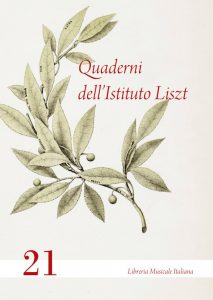SAGGI
Marco Beghelli
Lettere di Jules Massenet a Madame Marchesi
Dieter Nolden
Liszt-Albumblätter
Daniele Tonini – Emanuela Marcante
“Le torri mi cascano sul naso…” I giorni e i luoghi di Liszt a Bologna nel 1838
GIANCOSIMO RUSSO
Alfonso Rendano e il suo Concerto per pianoforte e orchestra
 RECENSIONI
RECENSIONI
Newly discovered treasures: Unknown manuscripts of published works by Liszt. Facsimile edition of the new manuscripts in the holdings of the Liszt Ferenc Memorial Museum and Research Centre. Liszt Ferenc Academy of Music, Budapest, Liszt Academy – Liszt Museum, Budapest, 2020 [Rossana Dalmonte]
Denis Herlin – Cécile QUESNEY (éd.), André Caplet, compositeur et chef d´orchestre, Société française de musicologie, Paris, 2020 [Carlo Benzi]
Ida Zicari, Après une lecture du Dante. Fantasia quasi Sonata di Franz Liszt, il Corriere Musicale, Milano, 2017 [Calogero Di Liberto]
Albert Brussee, Mazeppa in the Romantic Arts. An interdisciplinary cultural-historic study, AB Music Production & Editions, The Hague, 2017
Albert Brussee, The Mazeppa music of Franz Liszt. Genesis, analysis and reception, AB Music Production & Editions, The Hague, 2019
Albert Brussee, Franz Liszt Mazeppa. An intermediate version (Urtext), AB Music Production & Editions, The Hague, 2019 [Rossana Dalmonte]
ABSTRACTS
Marco Beghelli, Letters from Jules Massenet to Madame Marchesi
Among the recent documentary acquisitions of the Fondazione Istituto Liszt, two letters from the composer Jules Massenet (1842-1912) to the German singing teacher Mathilde Marchesi (1821-1913), active in Paris at the turn of the century, stand out.
After a brief biography of Marchesi and her family, the professional relationship between the two artists is outlined and the two unpublished letters (16 October 1887 and 14 November 1899) are transcribed and commented on, explaining the references to facts and things therein mentioned.
Dieter Nolden, Liszt’s Album leaves
Recently, five album sheets have been found that have not been mentioned in Liszt research so far. On three of them, signatures of Liszt’s students have been collected, such as Eugen d’Albert, José Vianna da Motta, Richard Burmeister, Lina Grosscurth, Emma Koch, Felix Weingartner, Conrad Ansorge, Frédéric Lamond, Emil von Sauer, Max van de Sandt, Alexander Siloti and Martha Remmert. These sheets date from around 1930. Two album sheets were made by Liszt himself. One is from a concert in 1841, showing four measures for piano in F major in 4/4 time and the signature «Osnabrück, Nov. 12, 1841, F. Liszt». A comparable sheet is in the estate of the composer Fanny Hünerwadel with a Liszt signature from 1853.
Daniele Tonini – Emanuela Marcante, “Le torri mi cascano sul naso…”: Liszt’s stay in Bologna in 1838
On retracing Liszt’s steps during his two stays in Bologna in 1838 – the first accompanied by his companion Marie d’Agoult – one rediscovers a network of streets, palaces, gardens and artistic legacies that take us back into a world and an extensive city-museum that have in part been irredeemably lost. The juxtaposition between Bologna of the time and that of today offers us new insights into the urban and social fabric of the city and its evolution. At the same time it helps us to identify ancient routes and art destinations that still represent a wide-ranging patrimony always worthy of interest: palaces of the aristocratic and bourgeois élite still privately owned today or, in some important cases, acquired by institutions like the University of Bologna. Over and above his professional task of organising, during his first visit, concerts that would take place in the second, Liszt moved around the heart of Bologna as a typical “traveller”, just like today’s tourist, but also had the opportunity to enter some of the most striking and exclusive palaces as a guest or as a virtuoso pianist, making them resound with his music.
Giancosimo Russo, Alfonso Rendano and his Concert for piano and orchestra
This paper brings to the reader’s attention information regarding the existence of a private collection related to the composer and pianist Alfonso Rendano. It includes, inter alia, the autographed manuscripts of Consuelo, Quintetto per pianoforte e archi and Tarantella per pianoforte, in addition to all the orchestral parts of Concerto per pianoforte e orchestra, some printed by Ricordi in 1885, others non-autograph manuscripts, together with a manuscript score written after the author’s death. The paper then expands on the scores regarding the Concerto, with a performance history. Rendano’s Concerto was greatly appreciated by Liszt, who, in 1880, played the transcription for two pianos with the composer. Liszt promoted the Concerto in various ways, and even tried to have it performed in the Tonkünstler Versammlung in Weimar in 1884 and 1885, without success.